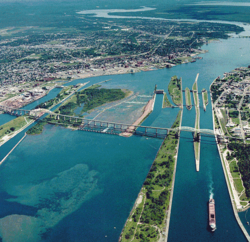Whitefish Island
Indian reserve in Ontario, Canada From Wikipedia, the free encyclopedia
Whitefish Island is an island in the St. Marys River, just south of Sault Ste. Marie, in Ontario, Canada.
Whitefish Island | |
|---|---|
| Whitefish Island Indian Reserve | |
 Aerial view of the St. Marys River; Whitefish Island is just to the left of the rapids. | |
| Coordinates: 46°31′N 84°21′W | |
| Country | Canada |
| Province | Ontario |
| District | Algoma |
| First Nation | Batchewana |
| Area | |
| • Land | 0.17 km2 (0.07 sq mi) |
| Population (2011) | |
• Total | 0 |
| • Density | 0/km2 (0/sq mi) |
| Time zone | UTC-5 (EST) |
| • Summer (DST) | UTC-4 (EDT) |
| Website | www.batchewana.ca |
| Official name | Whitefish Island National Historic Site of Canada |
| Designated | 1981 |
History
Summarize
Perspective
It was an ancestral fishing station to the Anishenabek of the Great Lakes region for over 2,000 years. It was reserved for the use of Chief Nebenaigoching and his band in the Robinson Huron Treaty, 1850 with the British Crown. In 1895, it became part of the west side of the Sault Ste. Marie Canal.
After it was taken in a series of expropriations from 1902 to 1913 for railway purposes, it became a park in the Parks Canada national inventory. The island was designated a National Historic Site of Canada in 1981.[1]
A land claim was filed in 1982 by the Batchewana Indian Band, of the Batchewana First Nation, for the 22-acre (89,000 m2) island. After years of unsuccessful negotiations, hereditary Chief Edward James Sayers Nebenaigoching occupied the island from 1989 until the claim was settled in 1992. $3.5 million in damages were paid to the tribe, and the island was returned to Indian reserve status in 1997.[citation needed]
- Welcome to White Fish Island
- Ancient fishing weir
- Birch bark longhouse
- Longhouse in winter
- Birch bark lodge
- Boardwalk with 7 flood control gates open (equivalent).
- Sault Ste. Marie waterfront, as seen from Whitefish Island
- St. Marys Rapids
- Beaver dams along Whitefish Channel
- February daphne flowers
- Narrow-leaf blue-eyed grass flowers near the St. Marys Rapids
- Trout-lily flower in early spring
- Wild leek in early spring
- Wild raisin in fruit
- Steelhead trout caught in the St. Marys Rapids (introduced species)
References
External links
Wikiwand - on
Seamless Wikipedia browsing. On steroids.


















